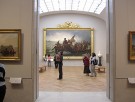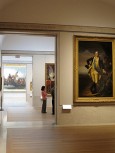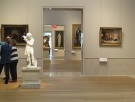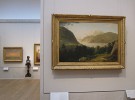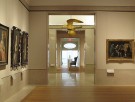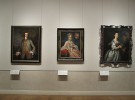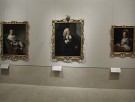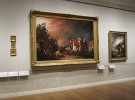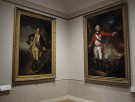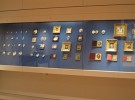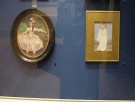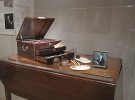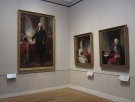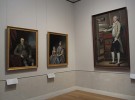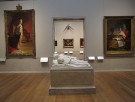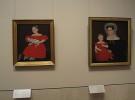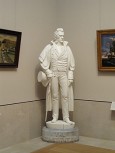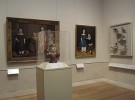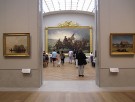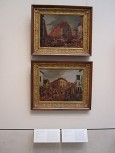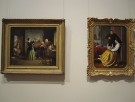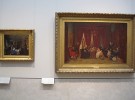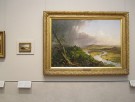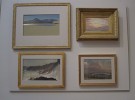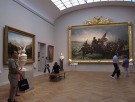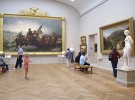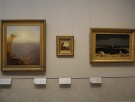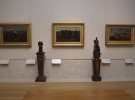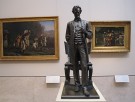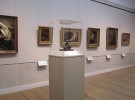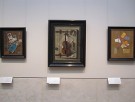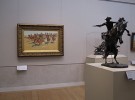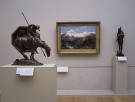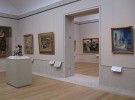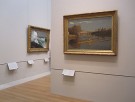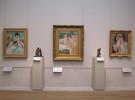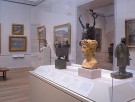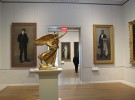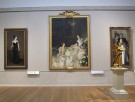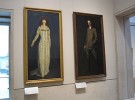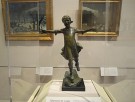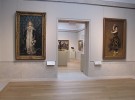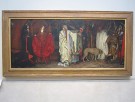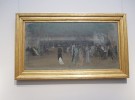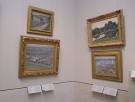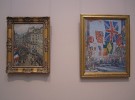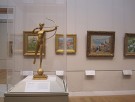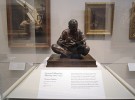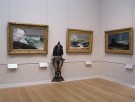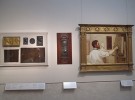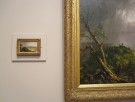The browser will either open the file, download it, or display a dialog.
The American Wing Galleries for Painting, Sculpture, and Decorative Arts, The Metropolitan Museum of Art, New York
Opened January 16, 2012
Kevin Roche John Dinkeloo and Associates, design architects
A brief tour of the gallery titled “History, Landscape, and National Identity, 1850–75.”
The approach to Emanuel Leutze's Washington Crossing the Delaware, 1851.
The New American Wing Galleries for Painting, Sculpture, and Decorative Arts at the Metropolitan Museum of Art (MMA) in New York reopened with much fanfare and political rhetoric on Monday, January 16, 2012. Both Secretary of State Hillary Rodham Clinton and New York City Mayor Michael Bloomberg gave remarks at the opening dinner, acknowledging the crucial role played by the Metropolitan Museum of Art in advancing American culture on the national and international stage. Linking art to politics in a predictably hyperbolic way, Clinton concluded her short speech with a patriotic and optimistic statement about how the New American Wing “holds the promise of what this country stands for, who we are as a people, and the kind of future we will make together.”[1] The newly refurbished galleries suggest that the MMA shares the Secretary of State’s sense of pride in, and grand aspirations for, historical American art. Since its inception in 1870, the MMA has acquired and promoted American art and arguably devotes more real estate than most, if not all, major museums to its presentation. Its newly conceived and re-organized galleries serve as a lofty setting to advance the grandiosity and masterpiece-status of American art in what might be considered a typically extravagant and larger-than-life New York manner. This effect is most obvious in the new core or “grand” gallery presided over by Emanuel Leutze’s “great picture,” Washington Crossing the Delaware in a spectacular, “eagle-crested” gilt frame, reproduced from photographs of the original (fig. 1). The ambitious character of the MMA’s presentation is further illuminated by comparing the installation of the Leutze with that of Thomas Sully’s “great picture” of Washington, The Passage of the Delaware (1819) in the new American Wing at the Museum of Fine Arts, Boston (MFA). In contrast to the MMA’s painting placed in an ample, arched space with skylights, the MFA, Boston’s Sully painting looks cramped in its gallery space, diminishing the commanding power of the image and visually tempering the stateliness and nobility of American art.[2] The two installations expose the enduring stereotypes of these two East coast cities, known respectively for their glitzy and puritanical characters.
Returning to the MMA’s galleries, I want to concentrate on their particular vision of American art in light of recent trends in art historical scholarship and museum practice as well as in terms of contemporary culture. How do the reconfigured galleries shape the visitor’s experience and perception of American art? What artists and themes are highlighted? To what extent do the installation and its architectural setting reinforce, or depart from, conventional narratives and iconic ideas about American art? Do the galleries succeed in making American art “relevant” to contemporary audiences?
Architectural Layout and Design
The opening of the twenty-three galleries of painting and sculpture on the second floor marked the culmination of a three-phase renovation of the American Wing, which began with the Charles Engelhard Court in May 2007. These galleries are the focus of this review.[3] Kevin Roche John Dinkeloo and Associates gave the galleries “the best facelift on the Upper East Side” as Mayor Bloomberg wittily commented. Eliminating the disorienting and hard to navigate mezzanine level and the multi-floor organization American Wing that Roche and his firm conceived in 1980, they have designed a space where visitors can perceive and explore the history of American painting and sculpture from 1730 to 1920 in an uninterrupted fashion. To be more precise, they can see what the MMA’s curators deem the masterpieces from the collection, and then if they want to see the depths of the collection, they can visit the Henry R. Luce Center for the Study of American Art on the floor below to continue their study of American art, an experience enhanced by new touch-screens on kiosks at the end of each aisle, making the collection easier to search and specific works easier to locate.
The redesign and enlargement of the gallery space simultaneously pays homage to the past and embraces contemporary ideas about museum installations. In an effort to focus attention on the artworks themselves and to enhance their masterpiece status, the American Wing galleries reconstruct the look and feel of Richard Morris Hunt’s original nineteenth-century Beaux-Arts museum interiors with their high, vaulted ceilings, light-colored walls, skylights, and oak floors with limestone trim, which visually prescribes the distance that the viewer must leave between her/himself and the artworks. The ordered and harmonious look of the galleries with their predominantly single-row arrangements of artworks is enhanced by hiding the HVAC system, so nothing distracts visually from the artworks on view. The redesign also embraces current trends in exhibition design, most specifically the idea of the impermanence and changeability of museum installations. A sliding system for hanging and wall label holders on a track facilitate future alterations to the works on view and their accompanying labels. As Elizabeth Mankin Kornhauser, the curator of the American Wing, explained, this presentation of the museum’s collection is not permanent, but ongoing.[4] Moreover, she welcomes dialogue and suggestions for future arrangements that may reveal shifts in scholarship and, more broadly, in society.[5] Her offer echoes recent thinking about the museum as an institution that must remain responsive to contemporary times, relevant, and up-to-date rather than entrenched in the past.
In fact, the galleries themselves are arranged so as to encourage and foster a cross-temporal dialogue among the artworks. Consequently, sight lines play an essential role in the installation, offering views from one gallery to the next and creating an enfilade effect along the main walkways. In one direction, the visitor can trace visually the portraits of George Washington by Charles Willson Peale (ca. 1779–81), Gilbert Stuart (ca. 1800), and Emanuel Leutze (1851) (fig. 2). Then, after turning the corner to the left and walking through a gallery of genre scenes, later portraits from the Gilded Age to the Ashcan school come into view (fig. 3). In other instances, as with the landscape painter John Frederick Kensett, a mid-career and a late work appear in adjoining rooms along the same sight line, revealing the artist’s departure from conventional framing and light effects in his final images of the Connecticut coast (fig. 4). For those familiar with Kensett’s Hudson River scenes, his Last Summer’s Work may come as a surprise given that it predates Impressionism, yet shares the Impressionist and post-Impressionist fascination with atmospheric light effects and the flattening of the picture plane.
The well-spaced artworks and labels with contextual details as well as overviews of each theme or period in every gallery make the installation visitor-friendly. The layout also grants the viewer the freedom to progress forward or backward in time depending on which entrance is used on the second floor. The galleries, with a few exceptions, have multiple doorways, allowing visitors to construct their own path as they explore the collections. For example, one might opt to proceed through the central walkway, tracing the history of portraiture from Copley to Peale to Sargent to Henri; or to wander off the main path to investigate the folk tradition or Hudson River School landscape painting. The curators cleverly used William Rush’s eagle in the “John Singleton Copley” gallery to direct visitors to the left so they will turn the corner to continue their tour through the paintings and sculpture galleries (fig. 5). This semaphore, however, effectively marginalizes the decorative arts in the gallery adjacent to the Copley paintings, and it also repurposes Rush’s eagle, which initially was constructed to support the sounding board for the pulpit in Saint John’s Evangelical Lutheran Church in Philadelphia.
The more viewer-friendly and integrated space has its drawbacks. The harmonious atmosphere and similarity of the installations from one gallery to the next create the illusion of a unified and continuous history of American art. The appearance of the galleries themselves, therefore, seems to threaten, if not nullify, the class, ethnic, and regional distinctions, which have become fundamental to recent histories of American art, as advanced in survey textbooks, including American Encounters and Framing America.[6] Significantly, the MMA does not deny the multiplicity of American art. Texts on the labels, not visual cues, elaborate its complexities and its local and cross-cultural influences. The question lingers whether this approach is successful at a time when attention spans are short and information seems best conveyed through visual means and first impressions.
Gallery Overview
The artworks in the twenty-three galleries are arranged in a largely chronological fashion interspersed with some thematic groupings and rooms dedicated to one or two canonical artists. John Singleton Copley has his own gallery, and Winslow Homer and Thomas Eakins share a space, though works by all three artists appear in other galleries as well. The installation puts particular emphasis on the genre of portraiture, Hudson River School landscapes, and American Impressionism, all regarded as strengths of the collection.
The American Wing starts with the Colonial period in the Anthony W. and Lulu C. Wang Galleries of Eighteenth-Century American Art. The first room titled “Colonial Portraiture, 1730–76,” contains formal portraits by native-born John Singleton Copley and Robert Feke, Scottish émigré John Smibert, and British-born artists Joseph Blackburn and John Wollaston (fig. 6). While these paintings express the ideals and tastes of a wealthy East coast society, a portrait of a Spanish colonial countess offers a related yet distinct approach to portraiture, and Matthew Pratt’s The American School (fig. 5), which portrays members of Benjamin West’s studio in London, introduces the themes of the artist’s studio and international art education that are explored in greater depth in the nineteenth-century section of the American Wing. The succeeding gallery continues with the genre of portraiture but focuses on Copley’s depictions of men, women, and children (fig. 7). Moving into the next room means advancing into the “Era of the Revolution, 1776–1800” with its more varied group of subjects, such as Benjamin West’s Biblical and literary scenes; John Trumbull’s dramatic historical battle scene, The Sortie Made by the Garrison of Gibraltar (fig. 8); full-length portraits of statesmen and heroes, such as Charles Willson Peale’s George Washington; and marble portrait busts of George Washington by the Italian-born Giuseppe Ceracchi, and Benjamin Franklin by the French sculptor Jean-Antoine Houdon (fig. 9).
“Portraits in Miniature, 1750–1920” occupies a small, ancillary gallery on the left. As the visitor enters the room, the space illuminates, revealing a glass wall case filled with miniatures dating from the eighteenth century to the late nineteenth and early twentieth centuries, when this practice was revived after it had been eclipsed by the daguerreotype (fig. 10). The presentation highlights the work of women artists, especially Sarah Goodridge, Laura Coombs Hills, and Lucia Fairchild Fuller (fig. 11). Beside the case with the miniatures is a vitrine containing a miniature portrait painter’s box, ca. 1790s, showing the types of tools and materials used by these generally itinerant artists (fig. 12).
The next two galleries, “Faces of the Young Republic, 1789–1800” and “Portraiture and Still Life, 1800–1850” mark the beginning of the Joan Whitney Payson Galleries. They further the exploration of heroic portraits, such as Gilbert Stuart’s George Washington (fig. 13), and introduce middle-class portraiture by Ralph Earl (fig. 14); early nineteenth-century romantic and poetic portraiture by Samuel F. B. Morse and Thomas Sully; and still lifes, most notably by members of the Peale family. Prominently placed in the center of “Portraiture and Still Life, 1800–1850,” Thomas Crawford’s sculpture The Babes in Wood (fig. 15), a marble of an orphaned boy and his sister embracing and lying down on the forest floor in an eternal sleep, suggests that sculpture, like several of the paintings in this gallery, captured sentimental themes meant to elicit an emotional response from the viewer.
The adjacent gallery, “Art in the Folk Tradition, 1800–1900,” covers an entire century and a diversity of pictorial and sculptural practices: from painted portraits, such as Ammi Phillips’ Mrs. Mayer and Daughter (fig. 16), and monumental sculpture (in wood, not marble or bronze), such as William H. Rumney’s Andrew Jackson (fig. 17), to functional objects, including a sign with the archangel Gabriel originally from the Angel Inn in Guilford Center, New York (fig. 15), a case of duck decoys by various identified and unidentified makers, and a polychromed wood, phrenological head attributed to Asa Ames (fig. 18). The curators have expanded the presentation of the MMA’s folk art collection by securing extended loans from the American Folk Art Museum.[7] While the attention dedicated to a type of art that has risen in prominence over the last several decades is admirable, some scholars and visitors may wonder why it has to be separated from the other art on view.
Genre paintings of city and country life line the walls of the first of two galleries dedicated to “Life in America, 1830–60.” Divided roughly in half, one side focuses on rural, outdoor activities, including William Sidney Mount’s Cider Making and George Caleb Bingham’s Fur Traders Descending the Missouri (fig. 19), and the other side on urban and domestic scenes, as exemplified by two satirical New York City scenes by an unidentified artist (fig. 20), Francis William Edmonds’ The New Bonnet and Lilly Martin Spencer’s Conversation Piece (fig. 21). The theme of everyday American life reoccurs several galleries away, extending from 1860–80. This time, however, the sense of humor found in some of the earlier works is gone. Portraits, such as Seymour Joseph Guy’s The Contest for the Bouquet: The Family of Robert Gordon in Their New York Dining-Room and Eastman Johnson’s The Hatch Family (fig. 22), which depicts the Wall Street broker and later the president of the New York Stock Exchange surrounded by his family, appear along with representations of women and children by Johnson, Guy, Homer, and Saint-Gaudens, which evoke both the profound shifts in society during and after the Civil War and the need for “reassuring slices of human experience,” as explained in the gallery’s wall text.
Three galleries explore the development of Hudson River School landscape painting: “Emergence of the Hudson River School, 1815–50”; “History, Landscape, and National Identity, 1850–75”; and “Late Hudson River School, 1860–80.” Thomas Cole’s View from Mount Holyoke, Northampton, Massachusetts, after a Thunderstorm—The Oxbow (fig. 23) as well as five other landscapes by him and paintings by Frederic Edwin Church, Kensett, and Asher B. Durand are on view in the “emergence” gallery. Along with the finished oil paintings, a small oil sketch for The Oxbow and four sketches by Church (fig. 24) reveal the practice of sketching essential to this landscape painting tradition. “History, Landscape, and National Identity, 1850–75” is the grandest space in the installation with its double-sized room, skylight, and arched ceiling; it features large, panoramic landscapes. It visually conveys that American landscape painting came to rival history painting in significance and scale during the Civil War period and that American artists traveled abroad to find subject matter. Central to the installation in this gallery is a triumvirate of “great pictures,” Albert Bierstadt’s The Rocky Mountains, Lander's Peak, Leutze’s Washington Crossing the Delaware, and Church’s The Heart of the Andes (figs. 25 and 26; for a panoramic tour, see the video at the beginning of this review). The curators derived inspiration for their hanging from that at the Metropolitan Sanitary Fair in New York City in 1864, an event intended to stimulate “patriotic fervor and national pride” while raising money for volunteer efforts to support the troops in camps and hospitals.[8] To reinforce and explain this association, two, free-standing pedestals display reproductions of Mathew Brady’s photograph of the North Wall of the Art Gallery, Metropolitan Sanitary Fair, 1864, and an engraving from Frank Leslie’s Illustrated Weekly (April 1864). The third and final Hudson River School gallery includes landscapes by Sanford R. Gifford, George Inness, Martin Johnson Heade, Kensett, and Fitz Henry Lane, revealing the influence of the French Barbizon School, Charles Darwin’s theories, and the fascination with atmospheric light effects, though the controversial term “luminism” is carefully eschewed (fig. 27). In the Hudson River School galleries, the sculpture consists mostly of portrait busts of painters whose work is on view and marbles and bronzes that introduce the theme of Native Americans, such as Erastus Dow Palmer’s Indian Girl or the Dawn of Christianity (1853–56; this carving, 1855–56) and John Quincy Adams Ward’s The Indian Hunter (1860; this cast, before 1910).
The “Civil War Era, 1860–80” gallery features Homer’s depictions of the Civil War, most notably his paintings inspired by his earlier work as an artist-correspondent Prisoners from the Front and Rainy Day in Camp along with his post-war commentary, The Veteran in a New Field. A variety of perspectives on emancipation also are represented, as exemplified by the installation of Theodor Kaufmann’s painting On to Liberty, which portrays fleeing African Americans in a war-torn landscape that suggests their future remains uncertain; Augustus Saint-Gaudens’ bronze Abraham Lincoln: The Man (Standing Lincoln) with its embodiment of Lincoln as the Great Emancipator; and Winslow Homer’s painting Dressing for the Carnival, which depicts African Americans celebrating during Independence Day celebrations after emancipation (fig. 29).
Leaving behind war and turmoil, the gallery entitled “In the Artist’s Studio, 1865–1900” turns attention to the representation of artistic practice on one side and trompe l’oeil still lifes of studio props, most notably by William Harnett and John Peto, on the opposite wall (figs. 30 and 31). The succeeding gallery abruptly transitions to “The West, 1860–1920,” one of the few galleries where painting and sculpture are successfully given equal attention. Both paintings and bronzes of cowboys and soldiers by Frederic Remington are on view (fig. 32), and there is a poignant arrangement of Thomas Moran’s wilderness landscape, The Teton Range, just south of Yellowstone, designated in 1872 as a national park, flanked by James Earle Fraser’s exhausted American Indian in End of the Trail, and Hermon Atkins MacNeil’s proudly standing, A Chief of the Multnomah Tribe, a larger version of which was used in the sculptor’s monument, The Coming of the White Man (fig. 33).
In contrast to the indigenous character of “The West,” “The Cosmopolitan Spirit, 1860–1900” includes paintings by Edwin Austin Abbey, William Merritt Chase, Henry Ossawa Tanner, and James Abbott McNeill Whistler and sculpture by Paul Wayland Bartlett and Olin Levi Warner, that attests to the international and cross-cultural interests of American artists and their patrons. Their increasingly easy access, through travel or published images, introduced them to foreign places with seemingly exotic ways of life and activities, such as bear taming and candy blowing (fig. 34). Canonical paintings by Winslow Homer and Thomas Eakins fill the next gallery and distinguish Eakins as a master of the portrait and Homer as a master of the sea, as exemplified by Eakins’ The Champion Single Sculls (Max Schmitt in a Single Scull) and Homer’s Northeaster (fig. 35).
“Images of Women, 1880–1910” returns to the theme of domesticity explored in several earlier galleries, focusing on women, sometimes with children, engaging in care-taking or leisure activities in domestic spaces. Along with the usual depictions of women by male artists, representations of female figures by the painter Mary Cassatt and the sculptor Bessie Potter Vonnoh alternate on one side of the room, showing female artists’ characterizations of their own gender (fig. 36).
Two galleries present the MMA’s extensive holdings of works by so-called American Impressionists, including William Merritt Chase, Childe Hassam, Theodore Robinson, John Singer Sargent, John H. Twachtman, and J. Alden Weir. Their vibrant and painterly portrayals of American and European landscapes and scenes of daily life, with and without figures, contrast with the more traditional allegorical and mythological subject matter of the sculpture by Daniel Chester French, Evelyn Beatrice Longman, Augustus Saint-Gaudens, and John Quincy Adams Ward (fig. 37). A similar contrast of painting and sculpture occurs in the next gallery, “Portraiture in the Grand Manner, 1880–1900,” which as the title suggests, returns to the genre of portraiture though Saint-Gaudens’ sculpture Victory does not fit into this category (fig. 38). Here, full-length portraits of wealthy American and European sitters by Chase, Eakins, Sargent, and Whistler replace the heroes and statesmen found in earlier galleries. Even celebrated artists became the subjects of grand manner portraits. Sargent’s representation of William Merritt Chase (1902) appears across the gallery from his society portraits of Madame X (Madame Pierre Gautreau), The Wyndham Sisters, and Mr. and Mrs. I. N. Phelps Stokes (fig. 39).
The genre of portraiture connects the penultimate and the final galleries. Juxtaposed on the far wall, which can be viewed from the prior room, are two full-length portraits by the Ashcan School artist and member of the Eight, Robert Henri: The Masquerade Dress, which depicts his second wife, the Irish-born Marjorie Organ, and F. Ambrose Clark, which represents “a gentleman jockey,” whose wealthy family commissioned this painting (fig. 40). The rest of the gallery features smaller-scale genre paintings with New York settings and portraits by other members of the Ashcan school and the Eight, including William Glackens, George Luks, John Sloan, and Maurice Prendergast. The sculpture in this room coincides with the subjects of the paintings better than in the prior rooms, as revealed by Abastenia St. Leger Eberle’s bronze, Girl Skating (1906), which captures the urban poor in a manner that corresponds to that in the work of the Ashcan School artists and the Eight (fig. 41).
Analysis of Themes and Content
The MMA’s new galleries adhere to the canon of American art advanced in the prior installation initiated in 1980. Artworks by white, male painters and sculptors who rose to prominence in major cities on the East coast dominate, as do depictions of white men, women, and children. The galleries generally privilege accepted masterpieces, often lining up along one wall at least three, and as many as five, works by celebrated artists, most notably Cassatt, Church, Cole, Copley, Eakins, Hassam, Homer, Saint-Gaudens, Sargent, and Stuart. Little room remains for artworks by lesser known American artists and for the introduction of visitors to a broader, more diverse range of American art. The masterpiece approach has additional shortcomings: it tends to favor the exceptions and the artists deemed more progressive and experimental, as exemplified by the exhibition of Copley’s and Hassam’s works. Filling an entire gallery with Copley’s revolutionary portraits does a disservice to the understanding of Colonial portraiture and misrepresents the significance of portrait painting in a culture that preferred aesthetically pleasing objects that also had a functional value. Similarly, showing eight of Hassam’s cityscapes and landscapes influenced by the French Impressionist style exposes the curator H. Barbara Weinberg’s preferences, as well as those of many visitors who adore all art associated with Impressionism, but it denies a more balanced and heterogeneous assessment of the late nineteenth-century, giving the illusion that Impressionism was the predominant art movement.
However, some of the thematic groupings and label texts as well as the individual galleries dedicated to miniatures and folk art acknowledge the more balanced scholarly approach to American painting and sculpture that has emerged during the last three decades. The new galleries suggest a more inclusive idea of American art, both geographically and in terms of medium, but the results of these efforts are mixed, due partly to the limitations of the MMA’s collections and the strict divisions among the museum’s curatorial departments.
As in many large museums, the temporal and national boundaries of individual departments established long ago limit the types of artworks on view in each section of the museum. At the MMA, the American galleries do not present American art according to the hemispheric concept of Art of the Americas, which has shaped recent scholarship and art historical investigation. Native American and Pre-Columbian objects do not appear in the American galleries, because they belong to separate departments in the museum.
Kornhauser and her colleagues have attempted to bridge some departmental boundaries and have attended to significant lacunae in the MMA’s collection by securing loans from other institutions and private collectors. For example, they borrowed from a private collection a Spanish colonial portrait of Doña Rosa Marìa Salazar y Gabiño, Countess of Monteblanco and Montemar, attributed to Cristóbal Lozano, a leading painter in Lima, Peru, and juxtaposed it with a portrait of a New Yorker by John Wollaston and a portrait of a New Englander by Joseph Blackburn (fig. 6). Although all three portraits depict wealthy sitters, exposing the elitist character of painting during the eighteenth-century, the wall labels elaborate the complexity of their cross-cultural associations: the Countess’ portrayal reveals the influence of French fashion in the New World while the other two paintings show the impact of British portraiture and fashion along the East coast, reinforcing the multicultural sources of American art in the first gallery.
Starting with the initial gallery, the vision of American art at the MMA is cosmopolitan and cross-cultural, albeit in a narrow, mostly American-European sense. In this respect, the installation dovetails with current ideas about American art and culture shaped by a post-national perspective, which disavows the notion of American exceptionalism. In “The Cosmopolitan Spirit, 1860–1900” gallery, the global and worldly outlook is most explicit: on one side of the room appear views of then exotic and distant locales, such as Edwin Lord Weeks’ Indian scene, Rajah Starting on a Hunt; Robert Blum’s image of Japan, The Ameya, and Tanner’s religious scene set in the Middle East, Flight into Egypt (fig. 34). This gallery also attests to several areas of interest in American scholarship: American Orientalism or, more specifically, American representations of the Middle and Far East and the representation of the performing arts with British or European associations as in paintings, such as Chase’s Carmencita, a portrayal of the Spanish dancer who performed for him and his friends in his studio (fig. 42); Abbey’s King Lear, Act 1, Scene 1 (1898)(fig. 43); and Whistler’s Cremorne Gardens, No. 2 (fig. 44), a London amusement park known for its theatrical spectacles and fireworks. Furthering the international theme, specifically the influence of French art and culture on American artists, are the two galleries focused on “American Impressionism.” Direct comparison is made of works done at home and abroad by Theodore Robinson and Hassam. The arrangement of Robinson’s work consists of two paintings done at Giverny and two paintings done in the United States, in New York State and Connecticut (fig. 45). Influenced by Claude Monet whom he met and visited in Giverny, Robinson painted landscapes in Giverny that evoke the light effects and distinctive atmosphere associated with the works Monet did there, and in comparison, his American landscapes seem bolder and brighter. The Hassam juxtaposition consists of a Parisian and a later New York City street scene, visually expressing his portrayal of both American and European urban life (fig. 46). What are missing from the presentation of the cosmopolitan and international character of American art are direct comparisons of works by American and European artists. During the reconstruction of the galleries, Sargent’s Madame X and Cassatt’s Lydia Crocheting in the Garden at Marly (1880) among other American works were on view in the nineteenth-century European galleries. Now, no longer can visitors see these images in their European context; no longer can they directly compare Cassatt’s portrait to Berthe Morisot’s representation of female figures or Sargent’s Madame X to paintings by Gustave Courbet and Edouard Manet. Once again, discreet departments and galleries located in different sections of the museum stymie a full appreciation and understanding of these artworks and their cultural context.
Following recent tendencies in scholarship and museum practice, attention is focused not only on the cross-cultural, hybrid nature of American art, but also on its local character, specifically on how the collection relates to its New York context. As described in the gallery overview, three galleries are dedicated to the development of the New York based Hudson River School, and the core gallery of the entire installation consists of a re-hanging of three “great pictures” by Bierstadt, Leutze, and Church in the same placement as they appeared on the walls of a New York City event, the Metropolitan Sanitary Fair in 1864. Thus, a New York context lies at the center of the constellation of galleries despite the fact that the paintings in this room portray sites in Europe, South America, and the West. Scenes of New York City street life reoccur throughout the installation: two nineteenth-century genre scenes showing the congested, chaotic, and indecorous streets of the city by an unidentified artist are found in the section titled “Life in America, 1830–60” (fig. 20); in contrast, Childe Hassam’s Avenue of the Allies, Great Britain, 1918, a lively and celebratory view of Fifth Avenue decorated with flags from the Allies, Great Britain, Brazil, and Belgium as well as the United States, looking north from Fifty-third Street, hangs in second room of “American Impressionism” (fig. 46); and William Glackens’ Central Park, Winter,an orderly image of middle-class recreation, is located in the final gallery of Ashcan School works (fig. 41).
Departmental divisions also limit the range of media: no textiles are on view, and works on paper and photographs appear infrequently; exceptions include three Frederic Edwin Church landscape sketches borrowed from the Cooper Hewitt National Design Museum, New York, installed together in the “Emergence of the Hudson River School, 1825–50” gallery, and two daguerreotypes from the MMA’s photograph collection that appear alongside the portrait miniatures to illustrate how miniature painters sought to compete with the daguerreotype. Although the number of media remains limited, more attention than in the prior installation is dedicated to the relationship between painting and sculpture, underscoring the current emphasis on multi-media displays in museums and the increasing interest in sculpture among scholars. In almost every gallery, the curators have juxtaposed painting and sculpture. The sculptures sometimes consist of portrait busts of the artists on view. In the case of Augustus Saint-Gaudens’ Diana (fig. 47) and Paul Wayland Bartlett’s Bohemian Bear Tamer (fig. 34), these small-scale sculptures are used to link the second floor galleries to the sculpture court on the first floor where full-size versions of the works appear. Some of the painting and-sculpture juxtapositions enhance the understanding of a particular artist’s experimentation with two distinct media, while other arrangements show the same theme addressed in related yet disparate ways by a painter and a sculptor: for example, the placement of Remington’s The Bronco Buster in front of his oil on canvas painting titled On the Southern Plains, depicting American soldiers in the West, shows his approach to the dynamism of the American West in two different media (fig. 32). Similarly, Samuel Aloysius Murray’s bronze of Thomas Eakins suggests a sculptor’s interpretation of a painter’s activity in a gallery with many paintings depicting artist’s studios (fig. 48). The juxtaposition of Vonnoh’s sculpture, Young Mother, and Cassatt’s mother and child oil on canvases reveals the impressionistic handling and realistic emotion in both female artists’ depictions of women and children (fig. 36); and the placement of Eberle’s bronze Girl Skating in a glass case in front of Glackens’ Central Park, Winter makes it appear as though the young girl in the sculpture has “jumped out” of the painting of children sledding in Central Park (fig. 41). In other instances, the comparisons seem weak, even forced, leaving the visitor wondering about the connection. For example, Saint-Gaudens’ The Puritan appears in front of two Homer seascapes (fig. 49); and a display case of “American Public Sculpture” with its predominantly allegorical themes is located in the same gallery as a group of American Impressionist paintings by Sargent, Robinson, Twachtman, and others, emphasizing the conservative character of late nineteenth-century American sculpture as compared to the more progressive nature of painting at this time (fig. 37).
In addition to reworking the conventional narratives of American art, the galleries demystify and expose artistic creation. This underlying theme can be regarded as a response to contemporary concerns about “process” in the art world. Half of the gallery titled “In the Artist’s Studio” is dedicated to representations of painters, sculptors, and etchers engaged in their craft. In an inspired juxtaposition of painting and sculpture, a Kenyon Cox painting depicting Augustus Saint-Gaudens at work in his studio on a sculptural relief of the artist William Merritt Chase appears to the right of a series of low-relief portraits of artists and friends, giving a behind-the-scenes look at his process right next to his actual finished work (fig. 50). Two other rewarding commentaries on the painting process occur in the presentation of the miniature painter’s box (fig. 12) and the juxtaposition of the preliminary oil sketch and the finished painting of Cole’s The Oxbow (fig. 51). The repeated references to artistic process may be part of an appeal to contemporary audiences. It seems to address the current fascination with transparency in artistic production and with behind-the-scenes glimpses into the art world, as seen recently on television and in documentary films as well as in videos included in museum exhibitions.
Conclusion
Despite the restrictions and limitations of a large institution like the MMA, Kornhauser and the other American Wing curators have transformed the presentation of American paintings and sculpture, departing from the prior installation by incorporating a number of new artworks and thematic groupings that embrace recent scholarly approaches and contemporary culture. The redesigned space is considerably more inviting and accessible than the awkwardly arranged rooms that existed previously, but its Beaux-Arts-inspired architecture visually reinforces the status of the artworks as unapproachable masterpieces and insists on their uniformity. The appearance of the galleries, therefore, does not coincide well with contemporary views about a broader, more inclusive, and heterogeneous notion of American art like that advanced in the information on the wall labels and text panels. The apparent discord between setting and contents seems to convey a curatorial, and perhaps institutional, ambivalence about the significance of American art and its presentation to the public. Kornhauser, however, encourages “interventions” by scholars and contemporary artists, so maybe the galleries themselves will become lively sites of dialogue and change in the future.
For general information:
http://www.metmuseum.org/americanwing
For interviews with the MMA’s curators about the new installation on The New York Times website:
http://www.nytimes.com/interactive/2012/01/06/arts/
design/20120106-met-american-panos.html?ref=design
Isabel L. Taube
School of Visual Arts, New York
taubeisa[at]gmail.com
I want to thank Emily Burns, Douglass Foundation Fellow, the American Wing, Metropolitan Museum of Art, for the informative and engaging tour she gave me of the new American Wing galleries. Her insights were invaluable to this review.
[1] To listen to the opening remarks of the Secretary of State and the New York City Mayor, please visit http://www.metmuseum.org/collections/new-installations/american-wing/video-and-audio
[2] For an image of the MFA, Boston’s installation of Thomas Sully’s The Passage of the Delaware (1819), see fig. 9 in Sally Webster’s review of The Art of the Americas Wing, Museum of Fine Arts, Boston, in Nineteenth-Century Art Worldwide 10, issue 2 (Autumn 2011), http://19thc-artworldwide.org/autumn11/review-of-the-art-of-the-americas-wing-museum-of-fine-arts-boston.
[3] The American Wing, which opened in 1924, was a freestanding, three-story structure to the northwest of the MMA’s main building, designed by the American architect Grosvenor Atterbury (1869–1956). Then, in 1980, Kevin Roche, as part of his master plan for the museum, enlarged the wing to include galleries for paintings and sculpture and created the Charles Engelhard Court to link the wing to the main building. The current renovation, also by Roche and his architectural firm, seeks to correct a number of structural problems and reorganizes the painting and sculpture galleries on a single level.
[4] Conversation with Elizabeth Mankin Kornhauser on April 16, 2012.
[5] Kornhauser already has furthered this goal by organizing a symposium, “New Approaches to Presenting American Art,” which regrettably was not well advertised, to which she invited Adam Gopnik, Kathleen A. Foster from the Philadelphia Museum of Art, Professor Allan Wallach, and a diverse group of contemporary artists, including Chuck Close and Kara Walker, to respond to the new galleries. Walker not surprisingly was quite dismissive, condemning the installation for advancing the “American myth of the self-made man and self-made country.” She then criticized the Colonial portraits for their flat compositions and ugly sitters and proclaimed Winslow Homer’s paintings as the only “honest artwork.” In conclusion, she asked for permission to re-install the galleries, promising to enliven them and breakdown their unified vision of American art.
[6] Angela L. Miller, Janet C. Berlo, Bryan J. Wolf, and Jennifer L. Roberts, American Encounters: Art, History, and Cultural Identity (Upper Saddle River, NJ: Pearson Prentice Hall, 2008); Frances K. Pohl, Framing America: A Social History of American Art, 2nd ed.(New York: Thames & Hudson, 2008).
[7] The American Folk Art Museum sold its West 53rd Street building to the Museum of Modern Art in 2009 to help pay off its debt and relocated to a smaller space at 2 Lincoln Square. Its extended loan to the MMA, therefore, benefits both institutions.
[8] Kornhauser stayed true to Leutze’s original installation of his painting by reconstructing its frame, but in the case of Church, she departed from his selection of frame. Church’s panoramic landscape now has an elaborately carved gilt frame, which once was used by the artist and was cut down to fit this painting. Previously at the MMA, Heart of the Andes had been displayed in a replica of the dark wood frame with green drapery created for the Metropolitan Sanitary Fair installation and later reused for The Icebergs (1861, Dallas Museum of Art). Kornhauser defended her selection of frame, stating that Church would only have adopted the Metropolitan Sanitary Fair frame for special exhibitions and would have placed the painting in a gilt frame for a longer-term installation in a patron’s home. Conversation with Elizabeth Mankin Kornhauser on April 16, 2012.


